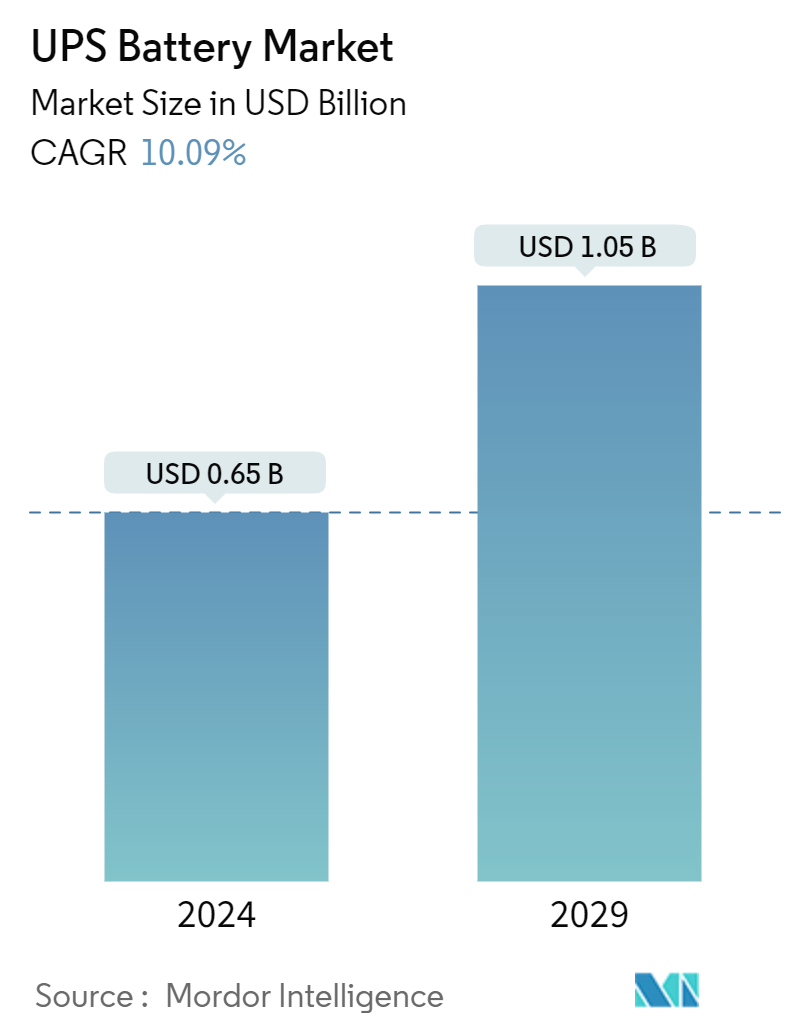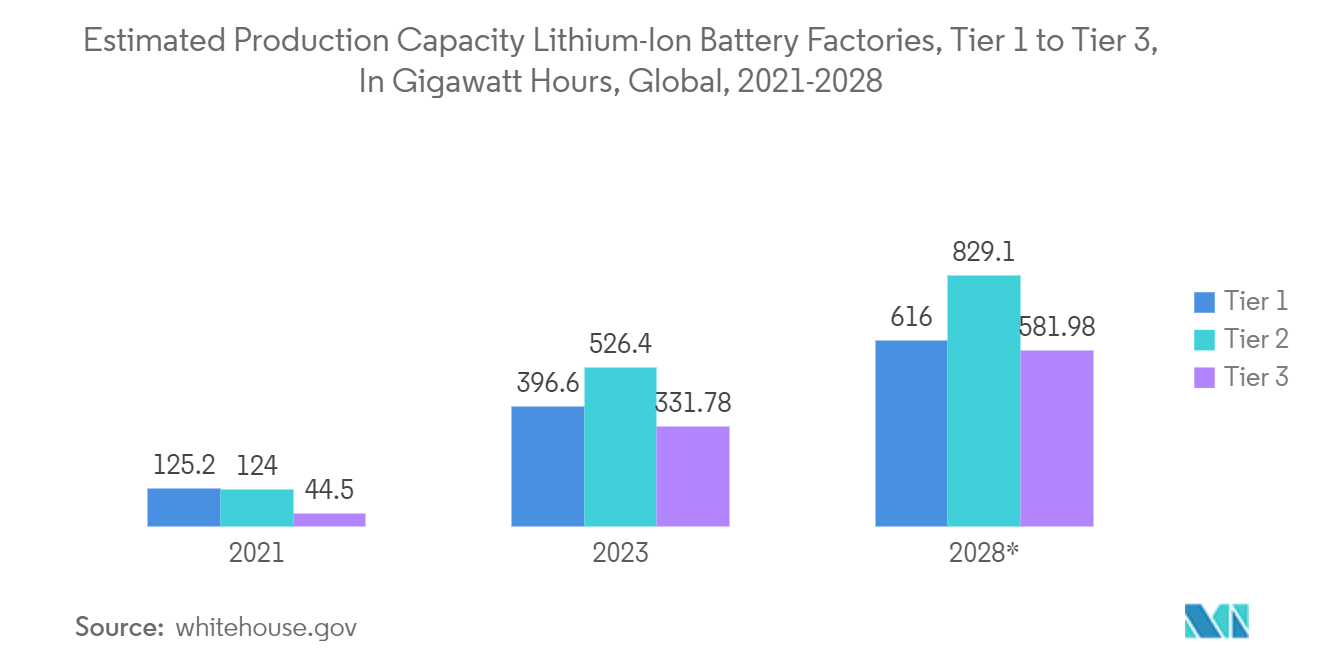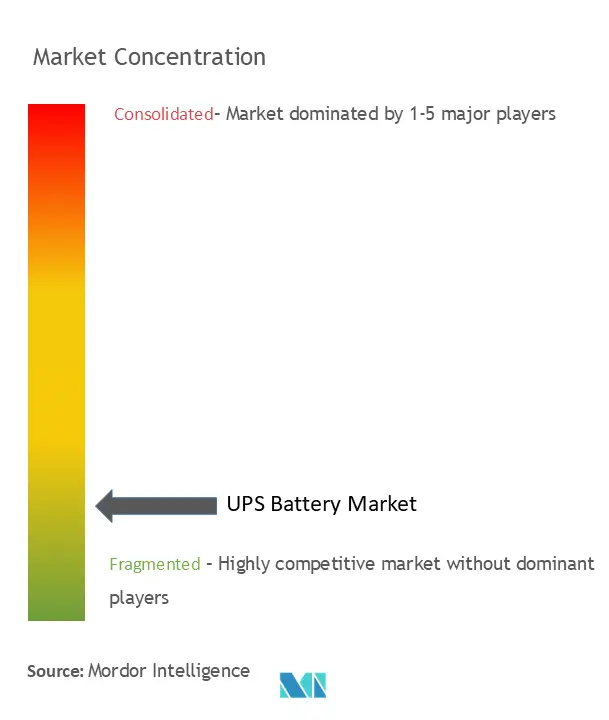UPS Battery Market Size

| Study Period | 2019 - 2029 |
| Market Size (2024) | USD 0.65 Billion |
| Market Size (2029) | USD 1.05 Billion |
| CAGR (2024 - 2029) | 10.09 % |
| Fastest Growing Market | Asia Pacific |
| Largest Market | North America |
Major Players
*Disclaimer: Major Players sorted in no particular order |
UPS Battery Market Analysis
The UPS Battery Market size is estimated at USD 0.65 billion in 2024, and is expected to reach USD 1.05 billion by 2029, growing at a CAGR of 10.09% during the forecast period (2024-2029).
- UPS batteries are crucial for backup power systems, ensuring seamless transitions during outages and fluctuations. As advanced battery chemistries like solid-state and flow batteries emerge, UPS battery technology stands on the brink of a significant transformation. These innovations promise higher energy density, longer service life, and enhanced safety features, paving the way for more efficient and reliable UPS systems. With ongoing R&D efforts focused on boosting energy storage capacity, reducing costs, and integrating smart grid functionalities, the future of UPS battery technology looks bright.
- The demand for eco-friendly UPS battery solutions intensifies as the world prioritizes environmental sustainability. Innovations in recyclable materials, energy-efficient manufacturing, and sustainable end-of-life management are shaping the future of UPS battery technology. Moreover, integrating renewable energy and the growth of electric vehicle infrastructure drive the demand for UPS batteries. In several regions, an ageing power infrastructure coupled with frequent natural disasters leads to an unstable power supply, heightening the need for reliable UPS systems to avert downtime.
- As the global economy increasingly embraces digitization and decentralization, the demand for UPS battery solutions is set to surge across various sectors and regions. Emerging markets are bolstering their critical infrastructure to combat power instability, while established industries are pursuing heightened efficiency and reliability. Furthermore, the market is witnessing a wave of new use cases and technological innovations. These dynamics suggest a steady influx of opportunities, propelling the market's growth.
- Lithium-ion batteries are poised to dominate the UPS battery market, especially for modular data center solutions. Their high energy density, long lifespan, and rapid recharge capabilities make lithium-ion batteries ideal for meeting data center power demands. Additionally, ongoing R&D efforts are expected to bring advancements in lithium-ion technology, particularly in safety and cost-efficiency.
- For small and medium-sized businesses, the upfront cost of purchasing and installing a UPS system, especially those with advanced lithium-ion battery technology, can be daunting. This significant initial investment might dissuade potential buyers. Furthermore, UPS batteries, particularly lead-acid types, have a limited lifespan and lose capacity over time, necessitating periodic replacements. These recurring replacement costs can strain a business's finances, potentially stunting market growth.
- Macroeconomic factors, such as energy price fluctuations, can influence the operating costs of UPS battery systems. Rising costs drive demand for more efficient systems and batteries that deliver superior performance with lower energy consumption. Additionally, government regulations targeting carbon emission reductions and energy efficiency promotion can sway demand towards more environmentally friendly and energy-efficient UPS batteries.
UPS Battery Market Trends
Lithium-Ion Batteries Segment is Expected to Witness a Significant Growth
- Businesses increasingly opt for lithium-ion (Li-ion) batteries in their UPS solutions. Due to their advanced technology, Li-ion batteries offer a lifespan that's twice as long as traditional batteries, along with reduced maintenance costs and quicker installation. Moreover, smart UPS solutions can significantly reduce the total cost of ownership (TCO), making them appealing to companies looking to upgrade their UPS systems. Li-ion batteries can effectively last up to 10 years, double the lifespan of lead-acid (VRLA) batteries, which also drives their adoption.
- Advancements in manufacturing, economies of scale, and increased production capacity have steadily driven down lithium-ion battery costs. This price drop has made lithium-ion UPS systems competitive with traditional lead-acid systems, fueling demand across multiple sectors. In May 2024, Vertiv, a leader in digital infrastructure and continuity solutions, announced an expansion of its Vertiv Liebert GXT5 Lithium-Ion double-conversion uninterruptible power supply (UPS) system. The new models in the Liebert GXT5 Lithium-Ion series will feature Global Voltage (GV) options, ranging from 5kVA to 10kVA, to meet varied application needs.
- The rollout of 5G networks and the expansion of telecommunications infrastructure necessitate reliable and efficient power solutions, driving up the demand for lithium-ion UPS batteries. In July 2024, the Indian government announced measures to strengthen the country's 5G ecosystem and allocated resources to boost research and development in the upcoming 6G sector.
- Driven by the rising adoption and diverse applications of Li-ion batteries across multiple industries, global production capacity for lithium-ion batteries is increasing. According to estimates by whitehouse.gov, the total production of Li-Ion battery factories is anticipated to surge from approximately 290 GWh in 2018 to an estimated 2,000 GWh by 2028.
- Furthermore, Lithium-ion batteries are more eco-friendly than lead-acid batteries, which contain harmful lead and acid. With a rising emphasis on sustainability and minimizing carbon footprints, businesses increasingly turn to greener technologies, such as lithium-ion UPS systems. As environmental regulations tighten, especially concerning hazardous material disposal, the shift to lithium-ion batteries is about compliance and minimizing environmental impact.

North America is Expected to Hold a Significant Market Share
- North America's economic, technological, and infrastructural dynamics significantly drive the demand for UPS batteries. The surge in big data analytics, IoT (Internet of Things), and cloud computing has spurred a boom in data centre construction across the continent. Since data centres require uninterrupted power to prevent costly downtimes, UPS systems have become indispensable. As edge computing and 5G networks gain traction, the heightened demand for data storage and processing underscores the reliance on dependable UPS batteries.
- In August 2024, Blackstone's portfolio includes data centres valued at a staggering USD 55 billion, encompassing operational and under-construction facilities. The firm's ambitious pipeline development surpasses USD 70 billion. Over the next five years, Blackstone is set to invest around USD 1 trillion in the U.S. alone, focusing on establishing and supporting new data centres. Not stopping there, they project an equal USD 1 trillion capital expenditure outside the U.S.
- North America's thriving e-commerce sector hinges on seamless operations, from order processing to warehousing. UPS systems play a significant role in safeguarding these operations from power disruptions, amplifying the demand for reliable UPS battery solutions. As retail businesses increasingly embrace digital tools, from point-of-sale systems to online platforms, the urgency for UPS battery systems to counter power disruptions has surged.
- Furthermore, the increasing trend of smart homes in North America, characterized by interconnected devices and systems, has heightened the demand for UPS battery systems. These systems ensure power continuity and shield sensitive electronics from fluctuations. As households increasingly invest in high-end consumer electronics, the demand for battery backup solutions has intensified, ensuring these devices remain operational during outages.

UPS Battery Industry Overview
The UPS Battery Market is fragmented, with the presence of major players like East Penn Manufacturing Inc., Eaton Corporation, Exide Industries Limited, Scheider Electric, CSB Energy Technology Co., Ltd., and many others. Players in the market are adopting strategies such as partnerships, mergers, innovations, investments, and acquisitions to enhance product offerings and gain sustainable competitive advantage.
- July 2024 - Vertiv and ZincFive collaborated to deliver reliable nickel-zinc battery energy storage solutions for data centre UPS systems throughout North America and EMEA. ZincFive's BC Series UPS Battery Cabinets emerge as the first-ever nickel-zinc energy storage solution, featuring backward and forward compatibility with megawatt-class UPS systems. Through this partnership, Vertiv plans to integrate ZincFive's BC Series UPS Battery Cabinets into its suite of battery systems tailored for data centre backup power.
- January 2024 - East Penn Manufacturing, a producer of premium lead batteries and accessories, serves various sectors, from automotive and commercial to marine, motive power, UPS, and telecommunications. East Penn Manufacturing unveiled its groundbreaking environmental initiative, Power2Recycle. This campaign highlights the collaboration between the lead battery industry and the general public, emphasizing the paramount importance of responsible battery recycling. The initiative showcases how individuals can significantly contribute to the industry's resource conservation goals, comprehensive recycling practices, and progress in carbon reduction technologies.
UPS Battery Market Leaders
-
East Penn Manufacturing Inc.
-
Eaton Corporation
-
Exide Industries Limited
-
Schneider Electric Inc.
-
CSB Energy Technology Co., Ltd
*Disclaimer: Major Players sorted in no particular order

UPS Battery Market News
- May 2024 - ABB Limited has added nickel-zinc (NiZn) batteries to its MegaFlex lineup, known for its high-power, high-density UPS solutions tailored for data centres and critical power applications. These NiZn batteries from ZincFive offer a safe, resilient, and sustainable energy storage alternative, distinguishing themselves from conventional chemistries. ABB's MegaFlex global UPS platform guarantees power availability, with capacities reaching up to 1.6 MW (UL) and 2.0 MW (IEC).
- February 2024 - Consistent Infosystems, an Indian firm renowned for its expertise in IT hardware, security and surveillance solutions, electronics, and home entertainment products, has launched its newest product: the Consistent UPS Battery. Designed to focus on efficiency, accuracy, and durability, the Consistent UPS Battery provides uninterrupted power during electrical outages or fluctuations. Whether safeguarding vital data centres, ensuring the continuity of essential services, or enhancing telecommunications infrastructure, this new UPS battery promises operational resilience and peace of mind in various settings.
UPS Battery Market Report - Table of Contents
1. INTRODUCTION
- 1.1 Study Assumptions and Market Definition
- 1.2 Scope of the Study
2. RESEARCH METHODOLOGY
3. EXECUTIVE SUMMARY
4. MARKET INSIGHTS
- 4.1 Market Overview
-
4.2 Industry Attractiveness - Porter's Five Forces Analysis
- 4.2.1 Bargaining Power of Suppliers
- 4.2.2 Bargaining Power of Buyers
- 4.2.3 Threat of New Entrants
- 4.2.4 Threat of Substitute Products
- 4.2.5 Intensity of Competitive Rivalry
- 4.3 Industry Value Chain Analysis
- 4.4 Impact of COVID-19 Aftereffects and Other Macroeconomic Factors on the Market
5. MARKET DYNAMICS
-
5.1 Market Drivers
- 5.1.1 Rising Incidents of Power Outages
- 5.1.2 Increasing Demand for Data Centers and IT Infrastructure
-
5.2 Market Restraint
- 5.2.1 Environmental and Regulatory Challenges
6. MARKET SEGMENTATION
-
6.1 By Type
- 6.1.1 Lithium-Ion
- 6.1.2 Nickel Cadmium
- 6.1.3 Lead Acid
- 6.1.4 Others
-
6.2 By Application
- 6.2.1 Residential
- 6.2.2 Commercial
- 6.2.3 Industrial
- 6.2.4 Power and Utilities
- 6.2.5 Others
-
6.3 By Geography***
- 6.3.1 North America
- 6.3.2 Europe
- 6.3.3 Asia
- 6.3.4 Australia and New Zealand
- 6.3.5 Middle East and Africa
- 6.3.6 Latin America
7. COMPETITIVE LANDSCAPE
-
7.1 Company Profiles*
- 7.1.1 East Penn Manufacturing Inc.
- 7.1.2 Eaton Corporation
- 7.1.3 Exide Industries Limited
- 7.1.4 Schneider Electric Inc.
- 7.1.5 CSB Energy Technology Co., Ltd.
- 7.1.6 ZincFive Inc.
- 7.1.7 Enersys Inc.
- 7.1.8 Fiamm Energy Technology S.p.A.
- 7.1.9 Leoch International Technology Limited
- 7.1.10 Vertiv Group Corporation
8. INVESTMENT ANALYSIS
9. FUTURE OF THE MARKET
** Subject To AvailablityUPS Battery Industry Segmentation
The UPS (Uninterruptible Power Supply) battery system actsbridges the primary power source and its backup. Yet, even with robust battery backups or generators, switching from the main power to the alternate source typically takes several minutes. These fleeting minutes can be pivotal in high-stakes environments such as hospitals and banks. The UPS mitigates this delay, providing immediate power and smoothly shifting to the backup once it becomes active.
The study tracks the revenue accrued through the sale of types of UPS battery products by various players globally as the baseline for market estimations. The study also tracks the key market parameters, underlying growth influencers, and major vendors operating in the industry, which supports the market estimations and growth rates over the forecast period. The study further analyses the overall impact of COVID-19 aftereffects and other macroeconomic factors on the market. The report's scope encompasses market sizing and forecasts for the various market segments.
The UPS battery market is segmented by type (lithium-ion, nickel-cadmium, lead-acid, and others), application (residential, commercial, industrial, power and utilities, and others), and geography (North America, Europe, Asia Pacific, Middle East and Africa, and Latin America). The market sizes and forecasts are provided in terms of value (USD) for all the above segments.
| By Type | Lithium-Ion |
| Nickel Cadmium | |
| Lead Acid | |
| Others | |
| By Application | Residential |
| Commercial | |
| Industrial | |
| Power and Utilities | |
| Others | |
| By Geography*** | North America |
| Europe | |
| Asia | |
| Australia and New Zealand | |
| Middle East and Africa | |
| Latin America |
UPS Battery Market Research FAQs
How big is the UPS Battery Market?
The UPS Battery Market size is expected to reach USD 0.65 billion in 2024 and grow at a CAGR of 10.09% to reach USD 1.05 billion by 2029.
What is the current UPS Battery Market size?
In 2024, the UPS Battery Market size is expected to reach USD 0.65 billion.
Who are the key players in UPS Battery Market?
East Penn Manufacturing Inc., Eaton Corporation, Exide Industries Limited, Schneider Electric Inc. and CSB Energy Technology Co., Ltd are the major companies operating in the UPS Battery Market.
Which is the fastest growing region in UPS Battery Market?
Asia Pacific is estimated to grow at the highest CAGR over the forecast period (2024-2029).
Which region has the biggest share in UPS Battery Market?
In 2024, the North America accounts for the largest market share in UPS Battery Market.
What years does this UPS Battery Market cover, and what was the market size in 2023?
In 2023, the UPS Battery Market size was estimated at USD 0.58 billion. The report covers the UPS Battery Market historical market size for years: 2019, 2020, 2021, 2022 and 2023. The report also forecasts the UPS Battery Market size for years: 2024, 2025, 2026, 2027, 2028 and 2029.
UPS Battery Industry Report
Statistics for the 2024 UPS Battery market share, size and revenue growth rate, created by Mordor Intelligence™ Industry Reports. UPS Battery analysis includes a market forecast outlook for 2024 to 2029 and historical overview. Get a sample of this industry analysis as a free report PDF download.



